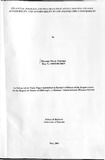| dc.description.abstract | Housing finance still remams the foremost challenge in the provision and accessibility of
adequate shelter to the bulk of low income urban households. Today we witness predominance of
two extreme outcomes of current shelter systems, adequate shelter that is unaffordable or
affordable shelter that is inadequate. Formulating and implementing policies and strategies that
can make shelter both accessible and affordable for the low income urban households remains the
principal challenge to most countries today.
This study reviews literature on accessibility and affordability of housing finance with a view of
identifying the financial policies and practices that affect accessibility and affordability of
housing finance by low income urban households. The study traces the evolution of housing
finance policies. Theories which inform housing finance accessibility and affordability by low
income urban household, as well as the current theoretical perspectives are also looked at.
Finally, empirical literature review on fiscal and monetary policies that affect housing finance
accessibility and affordability by low income urban households, practices by HFIs that inhibit
housing finance accessibility as well as incentives that facilitate accessibility of affordable
housing by low income urban households is undertaken. This is done with a view of determining
whether they have enhanced accessibility of housing finance by low income urban households.
Firstly, the study affirms that accessibility and affordability of housing finance for low income
urban households is a widespread problem in both developed and developing countries. In
addition factors contributing to accessibility and affordability problems are complex and diverse
with major driving factors found both within and beyond the housing system. Such factors
~
include the global rise in property prices over the past decade and, in particular the appreciation
of housing prices in the inner urban precincts of larger metropolitan areas. Secondly, the study
establishes that direct access to housing finance from banks for the low income urban households,
is extremely difficult due to lending practices, product design and selection criteria. HFI's require
that borrowers have a stable source of income; they prefer dealing with large loans in small
numbers to minimize administration costs as well as collateral with a clear title. Low income
urban households on the other hand do not have stable incomes, they would be better served with
many small loans and they lack clear titles. Thirdly, the role of microfinance in improving low
income households accessibility and affordability of housing finance in emerging markets has not
been fully explored. Finally, the impact of capital markets in mobilizing pension funds for
financing low income housing has not been adequately investigated particularly in the developing
countries. | en |

